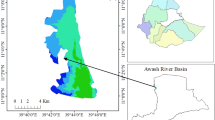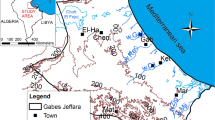Abstract
Water flow is required for the health and integrity of any wetland environment. Based on field investigation, flow simulation and hydrogeological data, a conceptual flow model representing the physical characteristics of the Sakumo wetland (Ghana) was developed. Two major flow systems were identified: interflow (local topsoil water) in the alluvium and shallow groundwater flow in the unconfined unit. A simple two-dimensional finite-difference numerical model was applied to analyse the groundwater flow system in the Sakumo wetland catchment using ModelMuse. The purpose of the model was to explain the groundwater flow system and quantify the water fluxes contributing to the wetland water storage. The main source of groundwater for use in the catchment is the shallow unconfined Quaternary aquifer. The modelling results indicate that changes in recharge significantly affect the wetland water balance. The water table declines during the dry season as there is high evapotranspiration with little rain. The modelling results also confirm that the Sakumo wetland water fluxes are predominately associated with local shallow flows; the calibrated model simulation showed no hydraulic link between the wetland and the underlying deep basement aquifer. This study thus provides valuable hydrogeological information on the Sakumo wetland basin and lays the foundation for development of detailed future predictive models in this under-researched area of hydrogeology in the humid tropics.
Résumé
Un écoulement d’eau est. nécessaire pour le bon état et l’intégrité de tout environnement de zones humides. A partir d’études de terrain, de simulations d’écoulements et de données hydrogéologiques, un modèle conceptuel d’écoulement décrivant les caractéristiques physiques de la zone humide de Sakumo (Ghana) a été développé. Deux systèmes majeurs d’écoulement ont été identifiés: un écoulement hypodermique dans les alluvions et un écoulement souterrain peu profond dans l’unité captive. Afin d’analyser les modalités d’écoulement dans le bassin versant de la zone humide de Sakumo, un modèle numérique bidimensionnel en différences finies a été développé sous ModelMuse. L’objectif du modèle était d’expliquer les modalités d’écoulement souterrain et de quantifier les flux d’eau qui contribuent à la rétention d’eau dans la zone humide. La principale source d’eau souterraine dans le bassin versant est. l’aquifère libre peu profond du Quaternaire. Les résultats de la modélisation indiquent que les modifications de la recharge affectent significativement le bilan en eau de la zone humide. Les niveaux piézométriques baissent durant la saison sèche du fait de l’évaporation élevée conjuguée aux faibles précipitations. Les résultats de la modélisation confirment également que les écoulements d’eau sont majoritairement associés à des écoulements locaux peu profonds dans la zone humide de Sakumo; la simulation sur le modèle calibré ne montre aucune relation hydraulique entre la zone humide et l’aquifère profond sous-jacent du socle. La présente étude fournit ainsi de précieuses informations hydrogéologiques sur le bassin versant de la zone humide de Sakumo, et établit la base de développement pour de futurs modèles prédictifs détaillés sur ce sujet insuffisamment étudié de l’hydrogéologie dans les tropiques humides.
Resumen
El flujo de agua es necesario para la salud e integridad de cualquier ambiente en un humedal. Sobre la base de investigaciones de campo, simulación de flujos y datos hidrogeológicos, se elaboró un modelo conceptual de flujos que representa las características físicas del humedal de Sakumo (Ghana). Se identificaron dos sistemas de flujo principales: el flujo intermedio (agua de la capa superficial del suelo) en el aluvión y el flujo de agua subterránea poco profunda en la unidad no confinada. Se aplicó un modelo numérico bidimensional simple de diferencias finitas para analizar el sistema de flujo de agua subterránea en la cuenca del humedal de Sakumo utilizando ModelMuse. El propósito del modelo era explicar el sistema de flujo de agua subterránea y cuantificar los flujos de agua que contribuyen al almacenamiento del agua en el humedal. La principal fuente de agua subterránea para su uso en la cuenca es un acuífero cuaternario no confinado y poco profundo. Los resultados del modelado indican que los cambios en la recarga afectan significativamente el balance hídrico del humedal. El nivel freático disminuye durante la estación seca, ya que hay una alta evapotranspiración con poca lluvia. Los resultados del modelado también confirman que los flujos de agua del humedal de Sakumo están predominantemente asociados con flujos locales poco profundos; la simulación del modelo calibrado no mostró ningún vínculo hidráulico entre el humedal y el acuífero subterráneo profundo subyacente. Por lo tanto, este estudio proporciona información hidrogeológica valiosa sobre la cuenca del humedal de Sakumo y sienta las bases para el desarrollo de modelos predictivos futuros detallados en esta área poco investigada de la hidrogeología en los trópicos húmedos.
摘要
任何湿地环境的健康和完整性都需要水流。基于现场调查,流动模拟和水文地质数据,开发了具有Sakumo湿地(加纳)物理特征的水流概念模型。确定了两个主要的流动系统:冲积层中的壤中流(局部表土水)和潜水含水单元中的浅层地下水流。采用ModelMuse建立了简化的二维有限差分数值模型以分析Sakumo湿地流域的地下水流动系统。该模型的目的是解释地下水流动系统并量化贡献湿地水储量的水通量。流域中主要地下水水源是浅层第四系潜水含水层。模拟结果表明,补给的变化显著影响湿地的水平衡。在旱季,因为蒸发蒸腾量很大,雨量很少,地下水位下降。模拟结果还证实,Sakumo湿地水通量主要与局部浅水流有关;经过识别的模型模拟表明湿地与下覆深部基岩含水层之间没有水力联系。该研究为Sakumo湿地盆地提供了有价值的水文地质信息,并为湿热带地区水文地质研究领域中详细的预测模型开发奠定了基础。
Resumo
O fluxo de água é necessário para a saúde e integridade de qualquer ambiente de zonas úmidas. Com base na investigação de campo, na simulação de fluxo e nos dados hidrogeológicos, foi desenvolvido um modelo de fluxo conceitual que representa as características físicas da área úmida de Sakumo (Gana). Dois grandes sistemas de fluxo foram identificados: interfluxo (água superficial local) no aluvião e fluxo subterrâneo superficial na unidade não confinada. Um modelo numérico bidimensional de diferenças finitas simples foi aplicado para analisar o sistema de fluxo de água subterrânea na bacia hidrográfica de Sakumo, usando ModelMuse. O objetivo do modelo foi explicar o sistema de fluxo de águas subterrâneas e quantificar os fluxos de água que contribuem para o armazenamento de água das áreas úmidas. A principal fonte de água subterrânea para uso na bacia é o aquífero quaternário livre. Os resultados da modelagem indicam que mudanças na recarga afetam significativamente o balanço hídrico da área úmida. O lençol freático declina durante a estação seca, pois há alta evapotranspiração com pouca chuva. Os resultados da modelagem também confirmam que os fluxos de água de zonas úmidas de Sakumo estão predominantemente associados a fluxos rasos locais; a simulação do modelo calibrado não mostrou nenhuma ligação hidráulica entre a zona úmida e o aquífero subterrâneo profundo subjacente. Este estudo, portanto, fornece informações hidrogeológicas valiosas sobre a bacia da área úmida Sakumo e estabelece as bases para o desenvolvimento de modelos preditivos futuros detalhados nesta área de hidrogeologia sob pesquisa nos trópicos úmidos.












Similar content being viewed by others
References
Adomako D, Maloszewski P, Stumpp C, Osae S, Akiti TT (2010) Estimating groundwater recharge from water isotope (δ2H, δ18O) depth profiles in the Densu River basin, Ghana. Hydrol Sci J 55(8):1405–1416
Agbevanu KT (2015) Modelling and simulation of groundwater flow and radionuclide transport in aquifers of Dahomeyan System of the Accra Plains in Ghana. MSc Thesis, University of Ghana, Accra, Ghana
Ameli AA, Creed IF (2017) Quantifying hydrologic connectivity of wetlands to surface water systems. Hydrol Earth Syst Sci 21(3):1791–1808
Anderson MP, Woessner WW (1992) Applied ground water modelling: simulation of flow and advective transport. Academic, New York
Anderson MP, Woessner WW (2002) Applied groundwater modelling: simulation of flow and advective transport. Academic, San Diego
Beretta GP, Terrenghi J (2016) Groundwater flow in the Venice lagoon and remediation of the Porto Marghera industrial area (Italy). Hydrogeol J. https://doi.org/10.1007/s10040-016-1517-5
Brannen R, Spence C, Ireson A (2015) Influence of shallow groundwater–surface water interactions on the hydrological connectivity and water budget of a wetland complex. Hydrol Process 29:3862–3877
Cohen MJ, Creed IF, Alexander L, Basu NB, Calhoun AJ, Craft C, D’Amico E, DeKeyser E, Fowler L, Golden HE (2016) Do geographically isolated wetlands influence landscape functions? Proc Natl Acad Sci 113:1978–1986
Crowe AS, Shikaze SG (2004) Linkages between groundwater and coastal wetlands of Laurenthian Lakes. Aquat Eco Health Manage 7(2):199–213
Darko PK, Barnes EA, Sekpey NK (1995) Groundwater assessment of the Accra Plains. Water Resources Research Institute, Accra, Ghana
Feinstein DT, Hunt RJ, Reeves HW (2010) Regional groundwater-flow model of the Lake Michigan Basin in support of Great Lakes Basin water availability and use studies. US Geol Surv Sci Invest Rep 2010-5068. US Geological Survey, Reston, VA
Freeze, RA and Cherry, JA (1979) Groundwater. Prentice-Hall Inc., Englewood Cliffs 7632,604
Ganyaglo SY, Osae S, Akiti TT, Armah T, Gourcy L, Vitvar T, Ito M, Otoo IO (2017) Application of geochemical and stable isotopic tracers to investigate groundwater salinity in the Ochi-Narkwa Basin, Ghana. Hydrol Sci J. https://doi.org/10.1080/02626667.2017.1322207
Ghana Statistical Service (2012) 2010 Population and housing census. Summary report of final results, Ghana Statistical Service, Accra, Ghana
Golden H, Creed IF, Ali G, Basu NB, Neff B, Rains M, McLaughlin D, Alexander L, Ameli AA, Christensen J, Evenson G, Jones C, Lane C, Lang M (2017) Integrating geographically isolated wetlands into land management decisions. Front Ecol Environ 15(6):319–327
Guay C, Nastev M, Paniconi C, Sulis M (2013) Comparison of two modeling approaches for groundwater–surface water interactions. Hydrol Process 27(16):2258–2270. https://doi.org/10.1002/hyp.9323
Gusyev MA, Haitjema HM (2011) Modelling flow in wetlands and underlying aquifers using a discharge potential formulation. J Hydrol 408:91–99
Haitjema HM, Mitchell-Bruker S (2005) Are water tables a subdued replica of the topography? Ground Water 44(6):781–786
Hunt RJ, Krabbenhoft DP, Anderson MP (1996) Groundwater inflow measurements in wetland systems. Water Resour Res 32:495–507
Jacob CE (1944) Notes on determining permeability by pumping test under water table conditions. US Geol Surv Open File Rep 1944, USGS, Reston, VA
Junner NR, Bates DA (1945) Reports on the geology and hydrology of the coastal area east of the Akwapim Range. Gold Coast Memoir 7, US Geological Survey, Reston, VA, pp 1–23
Krasny, J (1993) Classification of Transmissivity Magnitude and Variation. Ground Water 31 (2):230-236
McDonald MG, Harbaugh AW (1988) A modular three-dimensional finite-difference groundwater flow model. US Geological Survey Techniques of Water-Resources Investigations, book 6, chap A1, US Geological Survey, Reston, VA, 586 pp
Mendoza-Sanchez I, Phanikumar MS, Niu J, Masoner JR, Cozzarelli IM, McGuire JT (2013) Quantifying wetland–aquifer interactions in a humid subtropical climate region: an integrated approach. J Hydrol 498:237–253
Muff R, Efa E (2006) Environmental and engineering geology for urban planning in Accra and Tema. Ghana Geological Survey Dept. Bull. no. 55, Ghana Geological Survey, Accra, Ghana
Neuman, SP (1974) Effect of partial penetration on flow in unconfined aquifers considering delayed gravity response, Water Resources Research 10(2):303–312
Nonterah C, Xu Y, Osae S, Akiti TT, Dampare SB (2015) A review of the ecohydrology of the Sakumo wetland in Ghana. Environ Monit Assess 187:671. https://doi.org/10.1007/s10661-015-4872-0
Rosenberry DO, Lewandowski J, Meinikmann K, Nützmann G (2015) Groundwater: the disregarded component in lake water and nutrient budgets, part 1—effects of groundwater on hydrology. Hydrol Process 29:2895–2921
Rudnick S, Lewanski J, Nützmann G (2014) Investigating groundwater–lake interactions by hydraulic heads and a water balance. Ground Water 53(2):227–237
Theis CV (1935) The relation between the lowering of the piezometric surface and the rate and duration of discharge of a well using groundwater storage. Trans Am Geophys Union 16:519–524
Van der Kamp G, Hayashi M (2009) Groundwater-wetland ecosystem interaction in the semiarid glaciated plains of North America. Hydrogeol J 17:203–214
Winston RB (2009) ModelMuse: a graphical user interface for MODFLOW-2005 and PHAST. US Geol Surv Techniques Methods 6-A29
Winter TC (1999) Relation of streams, lakes, and wetlands to groundwater flow systems. Hydrogeol J 7:28–45
Winter TC, LaBaugh JW (2003) Hydrologic considerations in defining isolated wetlands. Wetlands 23:532–540
Yihdego Y, Webb JA, Vaheddoost B (2017) Highlighting the role of groundwater in lake–aquifer interaction to reduce vulnerability and enhance resilience to climate change. Hydrology 4(1):10
Acknowledgements
The authors wish to thank the Organization for Women in Science in the Developing World (OWSD) and Swedish International Development Cooperation Agency (Sida) for the intellectual and material contribution towards this research. Special thanks to Dr. Richard Winston for the software availability and Mr. Siyamthanda Gxokwe for ModelMuse introduction.
Author information
Authors and Affiliations
Corresponding author
Rights and permissions
About this article
Cite this article
Nonterah, C., Xu, Y. & Osae, S. Groundwater occurrence in the Sakumo wetland catchment, Ghana: model–setting–scenario approach. Hydrogeol J 27, 983–996 (2019). https://doi.org/10.1007/s10040-019-01959-4
Received:
Accepted:
Published:
Issue Date:
DOI: https://doi.org/10.1007/s10040-019-01959-4




